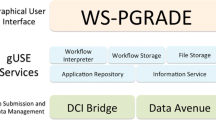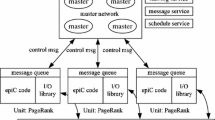Abstract
A Process Support System provides the tools and mechanisms necessary to define, implement and control processes, i.e., complex sequences of program invocations and data exchanges. Due to the generality of the notion of process and the high demand for the functionality they provide, process support systems are starting to be used in a variety of application areas, from business re-engineering to experiment management. In particular, recent results have shown the advantages of using such systems in scientific applications and the work reported in this paper is to be interpreted as one more step in that direction. The paper describes Geo-Opera, a process support system tailored to spatial modeling and GIS engineering. Geo-Opera facilitates the task of coordinating and managing the development and execution of large, computer-based geographic models. It provides a flexible environment for experiment management, incorporating many characteristics of workflow management systems as well as a simple but expressive process modeling language, exception handling, and data and metadata indexing and querying capabilities.
Preview
Unable to display preview. Download preview PDF.
Similar content being viewed by others
References
G. Alonso, D. Agrawal, A. El Abbadi, and C. Mohan. Functionality and Limitations of Current Workflow Management Systems. IEEE Expert, 12(5), September–October 1997.
G. Alonso and A. El Abbadi. Cooperative Modeling in Applied Geographic Research. In Proceedings of the International Conference on Cooperative Information Systems, CoopIS'94, Toronto, Canada, May 1994.
G. Alonso and A. El Abbadi. Cooperative Modeling in Applied Geographic Research. International Journal of Intelligent and Cooperative Information Systems, 3(1), May 1994.
M.P. Armstrong. Temporality in spatial databases. In Proceedings GIS/LIS, pages 880–889, November 1988.
G. Alonso, B. Reinwald, and C. Mohan. Distributed Data Management in Workflow Environments. In Seventh International Workshop on Research Issues in Data Engineering (RIDE'97), Birmingham, England, April 1997.
G. Alonso and H.-J. Schek. Database Technology in Workflow Environments. INFORMATIK/INFORMATIQUE (Journal of the Swiss Computer Science Society), April 1996.
A. Bernstein, C. Dellarocas, T.W. Malone, and J. Quimby. Software Tools for a Process Handbook. IEEE Computer Society, March 1995.
I.Z. Ben-Shaul and G.E. Kaiser. A paradigm for decentralized process modeling and its realization in the oz environment. In Proceedings of the 16th International Conference on Software Engineering, Sorrento, Italy, 1994.
Stephen Blott, Lukas Relly, and Hans-Jorg Schek. An open abstract-object storage system. In Proceedings of the ACM SIGMOD International Conference on Management of Data, Montreal, Canada, June 1996.
A. Bonner, A. Shrufi, and S. Rozen. LabFlow-1: A Database Benchmark for High Throughput Workflow Management. In Proceedings of the Fifth International Conference on Extending Database Technology (EDBT96), Avignon, France, March 1996.
B. Curtis, M.I. Kellner, and J. Over. Process Modelling. Communications of the ACM, 35(9):75–90, September 1992.
W. Deiters and V. Gruhn. Managing software processes in the environment MELMAC. In 4th ACM SIGSOFT Symposium on Software Development Environments, 1990.
C. Frye. Move to Workflow Provokes Business Process Scrutiny. Software Magazine, pages 77–89, April 1994.
M. Goodchild and S. Gopal. Accuracy of Spatial Databases. Taylor and Francis Ltd, 1989.
N.I. Hachem, M.A. Gennert, and Ward M.O. The Gaea System: A Spatio-Temporal Database System for Global Change Studies. In AAAS Workshop on Advances in Data Management for the Scientist and Engineer, Boston, Massachussetts, pages 84–89, February 1993.
N.I. Hachem, K. Qiu, M. Gennert, and M. Ward. Managing Derived Data in the Gaea Scientific DBMS. In Proceedings of the 19th International Conference on Very Large Databases, Dublin, Ireland, 1993.
M. Hsu. Special Issue on Workflow Systems. Bulletin of the Technical Committee on Data Engineering, IEEE, 18(1), March 1995.
Y.E. Ioannidis, M. Livny, S. Gupta, and N. Ponnekanti. ZOO: A desktop Experiment Management Environment. In Proceedings of the 22nd VLDB Conference, Mumbai (Bombay), India, September 1996.
M. Kamath, G. Alonso, R. Günthor, and C. Mohan. Providing High Availability in Very Large Workflow Management Systems. In In Proceedings of the Fifth International Conference on Extending Database Technology (EDBT'96), Avignon, France, March 1996. Also available as IBM Research Report RJ9967, IBM Almaden Research Center, July 1995.
R.H. Katz and et al. Design of a Large Object Server Supporting Earth System Science Researchers. In AAAS Workshop on Adavances in data Management for the Scientist and Engineer, Boston, Massachussetts, USA, pages 77–83, February 1993.
F. Leymann and W. Altenhuber. Managing Business Processes as an Information Resource. IBM Systems Journal, 33(2):326–348, 1994.
G. Langram. Temporal GIS design tradeoffs. In Proceedings GIS/LIS, pages 890–899, November 1988.
D.P. Lanter and H. Veregin. A Lineage Meta-Database program for propagating error in Geographic Information Systems. In Proceedings GIS/LIS, pages 144–153, November 1990.
C. Mohan, G. Alonso, R. Günthör, and M. Kamath. Exotica: A research perspective on workflow management systems. Bulletin of the Technical Committee on Data Engineering, IEEE, 19(1), March 1995.
C.B. Medeiros, G. Vossen, and M. Weske. WASA: A workflow-based architecture to support scientific database applications. In Proc. 6th DEXA Conference, London, 1995.
J. Meidanis, G. Vossen, and M. Weske. Using Workflow Management in DNA Sequencing. In Proceedings of the 1st International Conference on Cooperative Information Systems (CoopIS96), Brussles, Belgium, June 1996.
F.J. Radermacher. The Importance of Metaknowledge for Environmental Information Systems. In Proceedings of the 2nd Symposium on the Design and Implementation of Large Spatial Databases, Springer Verlag, volume 1, pages 35–44, August 1991.
T.R. Smith, J. Su, D. Agrawal, and A. El Abbadi. Database and Modeling Systems for the Earth Sciences. IEEE Bulletin of the Technical Committee on Data Engineering, 16(1):33–37, March 1993.
T. Smith, J. Su, A. El Abbadi, D. Agrawal, G. Alonso, and A. Saran. Computational Modeling Systems. Information Systems, 20(2), 1995.
H.J. Schek and A. Wolf. From Extensible Databases to Interoperability between Multiple Databases and GIS Applications. In Proceedins of teh 3rd Int. Symposium on Large Spatial Databases, Singapore, June 1993.
A.Z. Tong, G.E. Kaiser, and S.S. Popovich. A flexible rule-chaining engine for process-based software engineering. In Proceedings of the Ninth Knowledge-Based Software Engineering Conference, Monterey, CA, USA, 1994.
W.R. Tobler. A transformational view of cartography. The American Cartographer, 6(2):101–106, 1979.
P. van Oosterom and T. Vijlbrief. Building a GIS on top of the open DBMS Postgres. In Proceedings of EGIS'91, Brussels, Belgium, pages 775–787, April 1991.
J. Widom and S. Ceri. Active Database Systems. Morgan Kaufmann Publishers, 1996.
Q. Zhou and B.J. Garner. On the integration of GIS and Remotely sensed data: towards an integrated system to handle the large volume of spatial data. In Proceedings of the Second Symposium on Advances in Spatial Databases, pages 63–72, August 1991.
Author information
Authors and Affiliations
Editor information
Rights and permissions
Copyright information
© 1997 Springer-Verlag Berlin Heidelberg
About this paper
Cite this paper
Alonso, G., Hagen, C. (1997). Geo-Opera: Workflow concepts for spatial processes. In: Scholl, M., Voisard, A. (eds) Advances in Spatial Databases. SSD 1997. Lecture Notes in Computer Science, vol 1262. Springer, Berlin, Heidelberg. https://doi.org/10.1007/3-540-63238-7_33
Download citation
DOI: https://doi.org/10.1007/3-540-63238-7_33
Published:
Publisher Name: Springer, Berlin, Heidelberg
Print ISBN: 978-3-540-63238-2
Online ISBN: 978-3-540-69240-9
eBook Packages: Springer Book Archive




